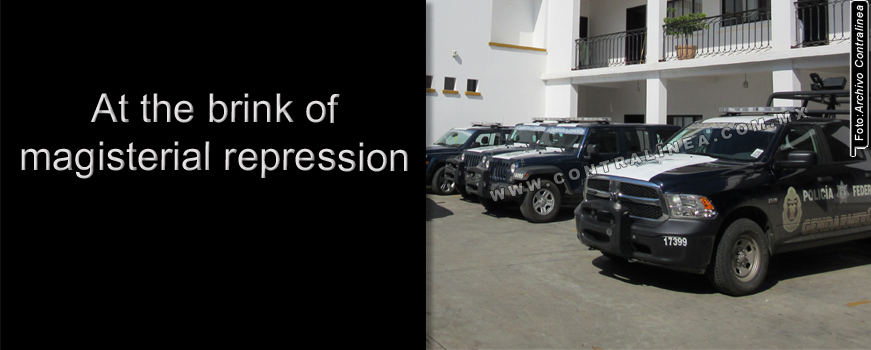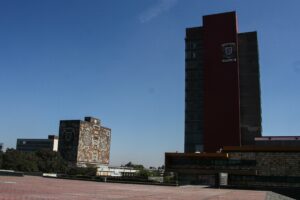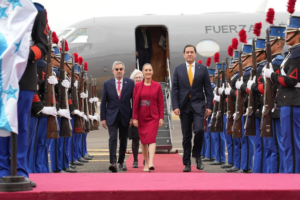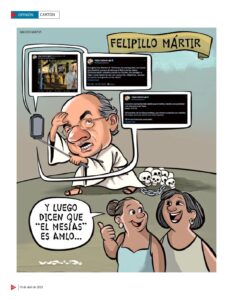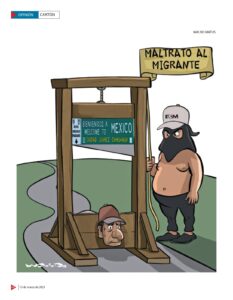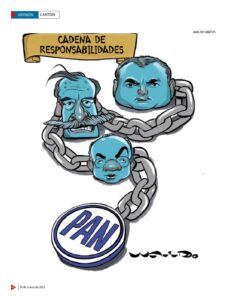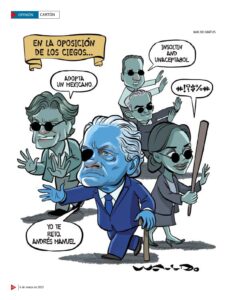The scenario to liquidate the magisterial movement is built up. Thousands of police and military forces are settled for weeks in the city of Oaxaca. Strategically the capital city of the State of Oaxaca is under siege by the federal police forces. Despite that the city remains in apparent calm –with the commercial activity, tourism and the money in full motion-, the ambience is of rising tension. The social effervescence has increased due to the coup given to the Section 22 with the cessation of the State Institute of Public Education of Oaxaca (IEEPO) and the alleged 35 apprehension orders issued against the leaders of the CNTE, and the federal police forces roaming.

Oaxaca de Juárez, Oaxaca, Mexico. Two are the details that receive anyone arriving by highway the Oaxacan capital: signs hanging of lightening posts with the brand of Infinitum, of Carlos Slim, that sponsor the official Guelaguetza (a folkloric cultural event in Oaxaca) and all-terrain vans with policemen and armed soldiers on board roaming everywhere.
Throughout the city there is calm tainted by tension, a tense string that announces the storm, meanwhile the rallies of the magisterial movement grow because of the cessation of the State Institute of Public Education of Oaxaca (IEEPO) and the disappearance of dozens of working places.
From the Fortin Hill until the surrounding municipalities there are two realities, two rhythms. On one side the commercial sector is delighting itself on the streets, on the sidewalks, on the public and private places, in the establishments and shops; in the flow of buyers, people strolling by and tourists blend with the second air, heavy, robust as the vehicles, the long arms, and the stone-like gestures of the Federal Police and Army.
Hundreds of gendarmes and federal police forces (with darkened glasses, assault rifles, urban camouflage wear, grey blue, and war boots) are positioned at diverse points of the city, before the polling day of the 7th of June. And since then they remained there.
According to what revealed by Contralínea and verified by various policemen consulted directly, the federal forces stationed at the hotels of the historic center, at the Secretariat of the State Public Security; at the so-called Judicial City, at the delegation of the Attorney’s General Office as well as at the airport.
From these provisional barracks uniformed personnel spreads out daily before the sights of astonishment for some, of fear or anger of others, and of satisfaction on behalf of the shop owners.
Among this thick ambience there is another group which seems to be happy: the businessmen of the hotel sector, before that complaining because of the social rallies, now happy because for weeks the low season has become the most profiting one of the year thanks to the armed guests that crowded the rooms and converted the chambers into a fort in which they had to pass thrice a day the roll call until Thursday the 16th, day on which they left these downtown rooms, as for their major happiness of the owners everything was booked for months before the festivities in July.
In any case the rank was determinant the commodity of each one: the commanders were installed in hotels of at least four stars; the gendarmes of three stars; meanwhile some federal policemen only reached a mat on the floor of the Ricardo Flores Magón Gym.
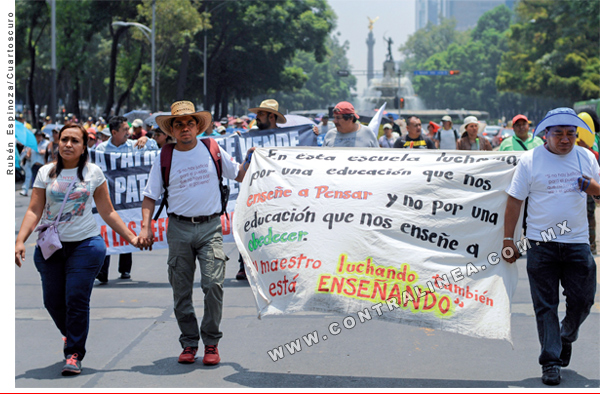
Entire streets were turned into parking area of Jeep Wranglers and Patriots, of bulky Nissan Titans, of Dodge Chargers and Ram patrols, of coaches.
Between the vertigo of the shops of clothes, mezcal, junk food, bread and anything else, the police is patrolling silently standing or in an impressive caravan in the few avenues of Oaxaca and its surrounding communities.
The military personnel are only visible on the vehicles with embedded sub-machine guns. Also men alone with civilian clothes but with a military court and very firm steps, very different to the tourists and residents, frequently making rounds in the first frame, between the tents of the teachers in resistance.
The monitoring is mobile. The policemen are not static, never anchored in a specific point, only in entrances and hotel lobbies. They loiter in alone or in groups of two by foot on the streets close to the main square (Zócalo); in groups of vans or cars in the areas, municipalities and surrounding roads.
In addition to the policemen that remained since the elections, thousands more arrived to the entity, admits the very own Secretariat of the Public Security of Oaxaca (SSPO).
“Over 6 thousand elements of the public security of the three levels of the government will look after the physical and proprietary integrity during the festivities of the months of July”, according to an official Press Communiqué of the entity led by Jorge Alberto Ruiz Martínez, who refused to answer to the interview request presented by this weekly magazine in the Offices of Social Communication of the Government Palace of the Government. However other sources report the presence of over 7 thousand federal policemen.
According to the official information, the public servant “explained that the Secretariat of Public Security and the Committee on Public Security, Traffic Control and the Municipal Civil Protection are deployed in a joint operation of 2 thousand elements [more] to warranty the security and tranquility of all the visitants and the inhabitants of Oaxaca during the festivities.
“These actions will be reinforced by 2 thousand additional federal police elements and 2 thousand members of the Gendarmerie that are already present since past week performing their activities of social proximity in the Oaxacan capital”, adds the SSPO on the 14th of July. Four days later arrived at least 500 policemen more.
These are the numbers diffused by the Secretariat itself. Nevertheless the popular sensation is that in reality there are many more, than the present elements, without counting the military personnel.

The taxi drivers, the sellers, the market women, the elder people in the parks, the teachers, the waiters, the hotel receptionists, the bus drivers, the neighbors of the outskirts of the city, the regional magisterial representatives and the local journalists, observe the density of the ambience by the presence of the “authority”. Contralínea held around thirty journalistic conversations on this subject, and after a while, unalterably the talk derives in the same memory: the state of siege and the repression afterwards in 2006.
The wounds provoked by the crushing under fire and blood of the Popular Assembly of the Peoples of Oaxaca (APPO) are still fresh and the snooping by the police revives the reminder of death related with the federal intervention.
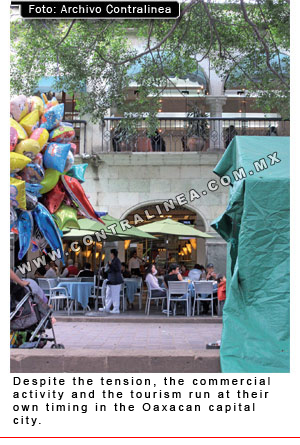 Furthermore, since before the festivities of the Guelaguetza 2015 the drones were already overflying the popular districts, especially the ones present on the Fortin Hill, taking pictures from very low altitude. Unknown people dressed as civilians stroll around those places which are not tourists. Including the silence of the dawn is interrupted by the sounds of planes that overfly again and again over the areas that showed some resistance during the crushing of 9 years ago, tell individually the interviewed residents.
Furthermore, since before the festivities of the Guelaguetza 2015 the drones were already overflying the popular districts, especially the ones present on the Fortin Hill, taking pictures from very low altitude. Unknown people dressed as civilians stroll around those places which are not tourists. Including the silence of the dawn is interrupted by the sounds of planes that overfly again and again over the areas that showed some resistance during the crushing of 9 years ago, tell individually the interviewed residents.
On their side, the magisterial movement and the diverse social organizations remain in the same places as always, on the usual roads, on marches whose departing point and destination are announced beforehand; the building of the Section 22 of the Magisterium is open and in permanent assemblies and radio broadcasts. The announcement of the cessation of the IEEPO further accelerates the rallies, while the gatherings, including on the main square of Oaxaca seem to be at the mercy of the being swept away by a small group of grenadiers, as it happened in Mexico City.
Days before the coup done on the magisterium, their presence was representative, almost symbolic in the State capital. The capacity of mobilization and support for the Section 22 of the National Union of Educations Workers (SNTE)- an organization based on more than two decades among the eight regions of Oaxaca- has made itself immediately visible after the decision, despite that the majority of its members were dispersed in the communities, in other states and the Federal District.
There are more than 80 thousand teachers who have shown resilience despite the killings, the enforced disappearances and the incarcerations in federal prisons: pending accounts and impunity that boost the rage and strengthen the political conviction before a new aggression overlapped by a discourse of order and reestablished social peace that foster the influx of tourism and thus the development of the capital concentrated in few hands.
The strategic dashboard is set: the higher parts, the entrance to downtown, the exits of the city are clearly covered, “brushed” in the police jargon. The roads to Xoxocotlán, Puerto Ángel, Monte Albán, Tuxtepec, Santa María del Tule, towards Atzomba and San Pedro Ixtlahuaca are being under custody.
The surveillance is permanent. The movement of the teachers that comes and goes, when the comrades are relayed; of where the rallies are heading at, where they are going to, with what aim, who is taking part, all of this is known by the federal police forces.
The police, military and gendarmerie presence on the daily basis keeps the strings tense. There have already been minor clashes: uniformed forces pointing taxi drivers, women being verbally harassed, vial chaos.
The collision vehicles and long arms have also had their roll call in Oaxaca.
The labor-educational reform has been already approved, it is launched by the massive media outlets and the Supreme Court of Justice of Mexico has endorsed it. Furthermore both parts, the government-entrepreneurial conglomerate and the teachers have manifested several times that they shall not give in.
The positioning of the federal forces and its movements are not guided by the hazard. The Armed Forces surround the city with a marked strategy. A circle, a network has spawn over Oaxaca. It is a corset that within minutes can close. Only an order is necessary, or a spark, for the valley to ignite. The governmental hammer is hangs over the Section 22 of the Magisterium.

The Alliance of the government and big businessmen
The magisterial movement is faced against a united front of public and private forces: federal, state and transnational ones.
The public and de facto powers coincide in an essential idea:: the National Coordination Committee of Education Workers (CNTE) is an obstacle, a barrier for neoliberal development, the support for free enterprise, inasmuch the struggle of the teachers is not circumscribed to the educational themes and its demands reach a greater social and economic spectrum.
In rallies, meetings and slogans persists the clarification that the fights given today are part of a class conflict: of the businessmen against the workers; of the few who own it all against the majority that is dispossessed: ”The Education, firstly to the son of the worker. Education, then to the son of the bourgeois” being one of the slogans.
Hence, one of the sectors of society who is mostly interested in the annihilation of the magisterial rallies being the business class.
The employer group Mexicanos Primero (Mexicans First), led by Claudio X González and the federal government converged unvarnished in the call for the education reform.
 Since September 2012, only a few days after that Enrique Peña Nieto had been declared president-elect by the Federal Electoral Tribunal (TEPJF), the industrialists association made their intentions public, and in written form, the document Ahora es cuando (Now is when), which on the page 30 had predicted what would come next:
Since September 2012, only a few days after that Enrique Peña Nieto had been declared president-elect by the Federal Electoral Tribunal (TEPJF), the industrialists association made their intentions public, and in written form, the document Ahora es cuando (Now is when), which on the page 30 had predicted what would come next:
“For 2013 the reform of the national judicial order should start, with changes in the General Education Act (LGE) and the regulation that follows.”
A day after taking oath, Peña Nieto committed, along with the signatories of the Pact for Mexico, to continuing the followed path and to reform the education sector. The February a year after the industrial’s intentions were upgraded to a constitutional level.
“We are just starting”, announced with self-confidence, the very own (Claudio) X González to the reporter Flor Goche in the beginning of 2014, despite of obtained to embody their intentions in the Political Constitution of the United Mexican States (Contralínea Issue No. 368).
And he was right: after that Sylvia Schmelkes, of the Consultation Council of Mexicanos Primero (Mexicans First) would become the President of the National Institute for the Evaluation of Education (INEE).
“Mexicans First was one of the groups that promoted various things [present in the reform]. It has been doing evaluations for some years and a lot of recommendations”, admits the PAN-Affiliated senator Juan Carlos Romero Hicks, president of the Education Committee of the Chamber of Senators. Also another organization of citizens-worried for the “quality” of the education and of their millionaire accounts, such as X González-contributed with their part, he added.
“We repudiate this entrepreneurial reform that will reduce the education system”, responded the teachers and intensified the mobilizations against the parliamentarian offensive: “Free education, what the people need”. “The fatherland is not for sale”.” The fatherland ought to be defended with dignity”, they proclaim.
The legislation derived from the entrepreneurial will was the quickest step that was given by the alliance. The following step consisted in the media lynching of the resistance that may arise against the labor-education reform.
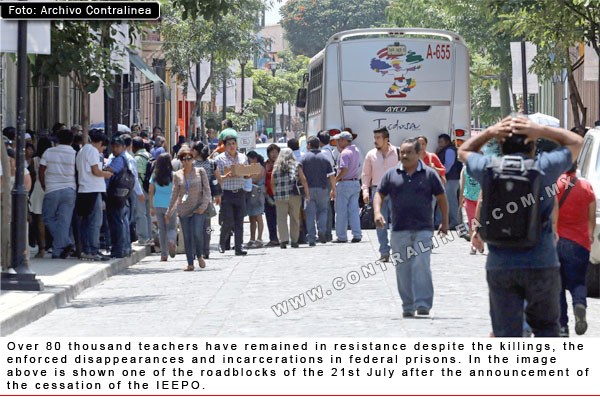
The dirty work of the media outlets
To destroy the image of the movement, to paint them as social scum, a criminal gang, a problem for everybody, whether they are owners of businesses or not, is the strategy used by a dozen of media outlets in the country.
The electronic and printed medias have committed to inoculate the idea that the schoolteachers of the Section 22 not only are failing to give a class, but also that their “extremely violent” struggle is motivated by personal interests.
For months the applied discredit has been raised in phases. Firstly they were called “resentful”, “lazy”, “good-for-nothing”; after they were even called “vandals”, “boorish”, “the teachirs of the disorder”; now the members of the Coordination Committee are called “criminals”, “organized crime”, “mafia” and last but not least, “terrorists”.
“Time has come for the competent authorities to sort out those peddlers” [sic], wrote Carlos García on the 8th of July of last year in the Milenio Diario newspaper, for example.
On the contrary of explaining the origin of the conflict, its tendencies, processes, facts, changes, incongruences, goals and ideas, the work done by several reporters, editors, columnists, radio and TV hosts have been focused in creating the image of a movement so dangerous for the country that it is necessary to finish with it once and for all, with “all the strength of the State”, judialization and violence included if possible.
With time the attacks, communiqués and appeals to “reestablish order”, until in the beginning of July the employers’ organization Mexicanos Primero filed a public lawsuit at Rubén Núñez Ginez, current leader of the Section 22, for “collecting without giving classes”, also threatening that it would pursuit the rest of the syndical “leadership”.
The green light from the Court
By the end of June 2015 the Supreme Court of Justice of Mexico, led by the minister Luis María Aguilar dismissed the amparo lawsuit presented by the CNTE against the education reform.
After the decision of the ministers, the media discourse went on to diffuse that the struggle was over, that the teachers would no longer have anything to fight for; that the highest court of the country had endorsed the reforms and that the only option was to go back, shut-up, to their communities.
The judicial justification was put on the table to invalidate the mobilization…and to motivate their dismissal.
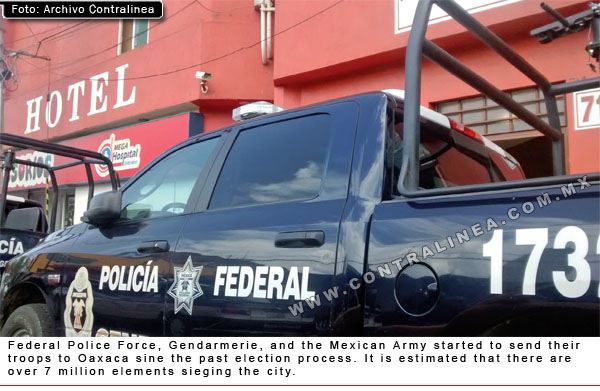
The harassment against the CNTE is rising
Oaxaca de Juárez, Oaxaca, Mexico. The cessation of the State Institute of Public Education of Oaxaca (IEEPO) was only the first impact of the series of coups by the federal and state governments against the National Coordination Committee of Education Workers (CNTE).
The bank account of the magisterial organization was also frozen, says to Contralínea Benito Vázquez Henestrosa, spokesman of the Section 22 of the National Syndicate of Education Workers (SNTE). Previously the authorities had sieged the city with solders, marines, gendarmes, federal and state police forces.
“They believe that from there we obtain the resources to finance the movement. But that is not so: everyone pays their own expenses”, assures minutes before joining an extraordinary state assembly, one of the many meetings organized and in which he took part, after that the federal government of Enrique Peña Nieto and the state (government) of Gabino Cué Monteagudo, announced in the morning of the past Tuesday 21st after the cessation of the IEEPO. Since then, the auditorium of the so-called hotel of the teachers to, they say, give an answer to what they consider an “attack of the Mexican State”.
Furthermore-resumes the spokesman of the only section of the SNTE that in its totality is also part of the CNTE- the alleged lawsuit put forward by the entrepreneurial Mexicanos Primero and the detention orders against the dozen of teachersare pending.
“Of neither of both do we know anything official”, assures Vázquez Henestrosa. As it seems –until the closing of this edition- the teachers had not received any notification over the lawsuit of the businessman Claudio X González against Rubén Núñez, Secretary-General of the Section 22, nor are the names of the accused in offenses such as attacks on the main roads, as several media outlets have broadcasted; a rumor that led that the teachers would close personally and with a truck the street of the headquarters of the Syndicate.
After thecoup received on the Tuesday 21st the arrival of thousands of federal forces –added to the already over 6 thousands of them that were present the previous weeks- to the Oaxacan capital city, the communication lines with the Federal Secretariat of the Interior and with the Government of Gabino Cué are broken. “We demand the reopening of the negotiation tables. But there has not been any response”, assures the spokesman.
Mauricio Romero, @mauricio_contra
(Translated by: Axel Plasa)
RELATED TEXTS:
Contralínea 447 / del 27 de Julio al 02 de Agosto 2015

